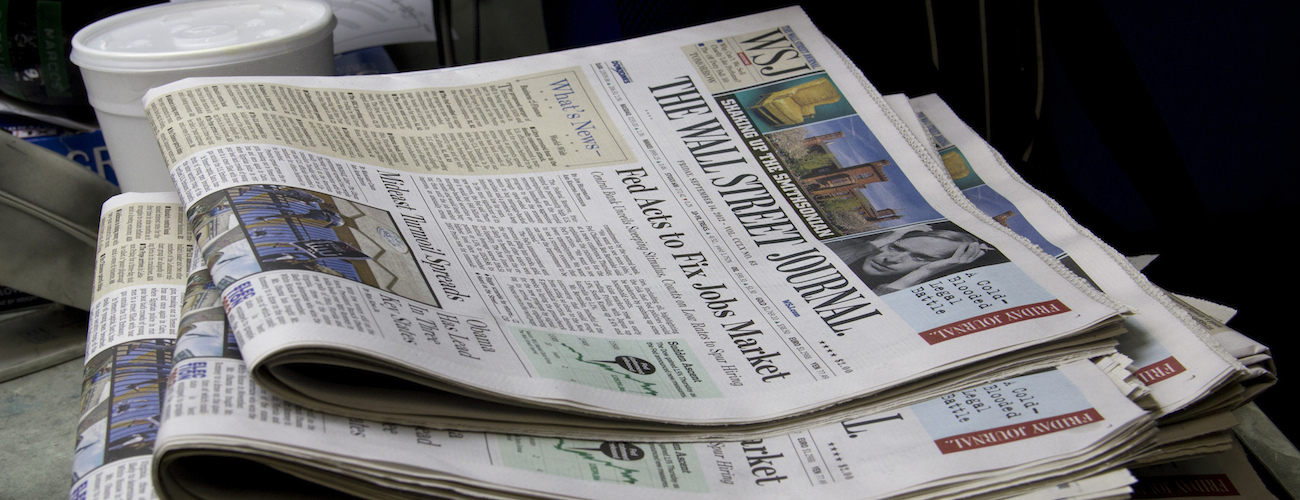Sign up for The Media Today, CJR’s daily newsletter.
A memo two weeks ago from Wall Street Journal Editor in Chief Gerard Baker offering buyouts to the paper’s entire editorial staff signaled stormclouds on the horizon for the news business.
Today, the deluge began.
The Journal said it will combine sections of its physical newspaper, resulting in less space devoted to arts, culture, and local news coverage, to cope with the decline in print advertising. Then, this afternoon, CNN’s Dylan Byers reported the paper had laid off every reporter in its “Greater New York” section–about three dozen people, each of whom will have the opportunity to apply for new jobs on a much smaller team. The newspaper also agreed to buyouts with 48 union members. The Wall Street Journal confirmed the moves in a statement to CJR.
Those reports came on the heels of a New York Times earnings report this morning with more bad news: Print ad revenues at the Gray Lady cratered 18.5 percent in the third quarter as compared to the same period last year, and the newspaper predicted the numbers would fall by a similar percentage in the fourth quarter.
The Times earnings report and changes at The Wall Street Journal come in the midst of a disastrous month for newspapers, as earnings reports from across the industry show newspapers are in even worse trouble than previously understood. The problem: Print advertising revenue has taken a sudden tumble, the worst pullback since the Great Recession.
The news follows last week’s grim earnings reports from Gannett (14.8 percent year-over-year drop in print advertising), McClatchy (17.2 percent drop), and Tronc (13 percent drop). Gannett’s loss was led by a 35.1 percent in drop in national print advertising, signaling a retreat from the field by national advertisers, with local businesses slower to follow. The Journal‘s parent company is scheduled to report earnings Monday.
The print advertising cliff is here for newspapers, people. Expect double-digit quarterly declines for the foreseeable future.
— Joshua Benton (@jbenton) November 2, 2016
The immediate implications of these developments are already being felt. In addition to the Journal’s cuts, Gannett has announced a two percent reduction in its workforce. In September, The Guardian said it planned to cut its US operation by 30 percent. And there is more to come: The newsroom at The New York Times is expected to shrink in 2017.
Uncertainty caused by the drop in print ad spending also played a role in the recent breakdown of Gannett’s attempted purchase of Tronc, which owns the LA Times and Chicago Tribune. Banks backing the deal pulled their funding amid growing concerns over Gannett’s unsteady financial footing as ad revenue tumbles, according to The Wall Street Journal.
Union memo on WSJ cuts: pic.twitter.com/0GqSGJvUDW
— Ben Mullin (@BenMullin) November 2, 2016
One reason for the decline is a shift, of both readers and ad buyers, from print to digital. The New York Times saw digital revenues grow by 21 percent, and Gannett said its national digital advertising rose 18 percent. The problem for publishers is that digital revenues have not come close to replacing their dead tree counterparts, a familiar refrain for journalists.
With the US presidential election less than a week away, journalists are fretting that newsrooms that expanded to cover the interminable campaign season may pull back from political coverage, resulting in additional cuts.
Related: Employment picture darkens for journalists at digital outlets
Print advertising, still the most lucrative revenue source for most newspaper companies, is in a freefall. The cash cow has steadily declined for years, but 2016 has seen an acceleration in the departure of ad dollars.
After a steep drop just after the 2008 recession, newspaper advertising had entered into a steady, but relatively stable decline. Between 2010 and 2015, print advertising fell between five and eight percent each year, according to the Pew Research Center.
In an analysis published last month, Interpublic Group’s Magna projected spending on print advertising would fall about 11 percent this year. That prediction now seems optimistic.
Analysts and ad buyers who spoke with CJR said that there is still value in print advertising, especially in luxury good categories as well as for advertisers interested in drawing quick responses from consumers for special events such as a weekend sale. They also saw value in audience engagement, an area in which print outperforms its digital and television competitors.
But with shrinking circulations and an inability to provide the targeted marketing and detailed analytics of options such as Google and Facebook, print just isn’t as enticing to advertisers.
Has America ever needed a media defender more than now? Help us by joining CJR today.



